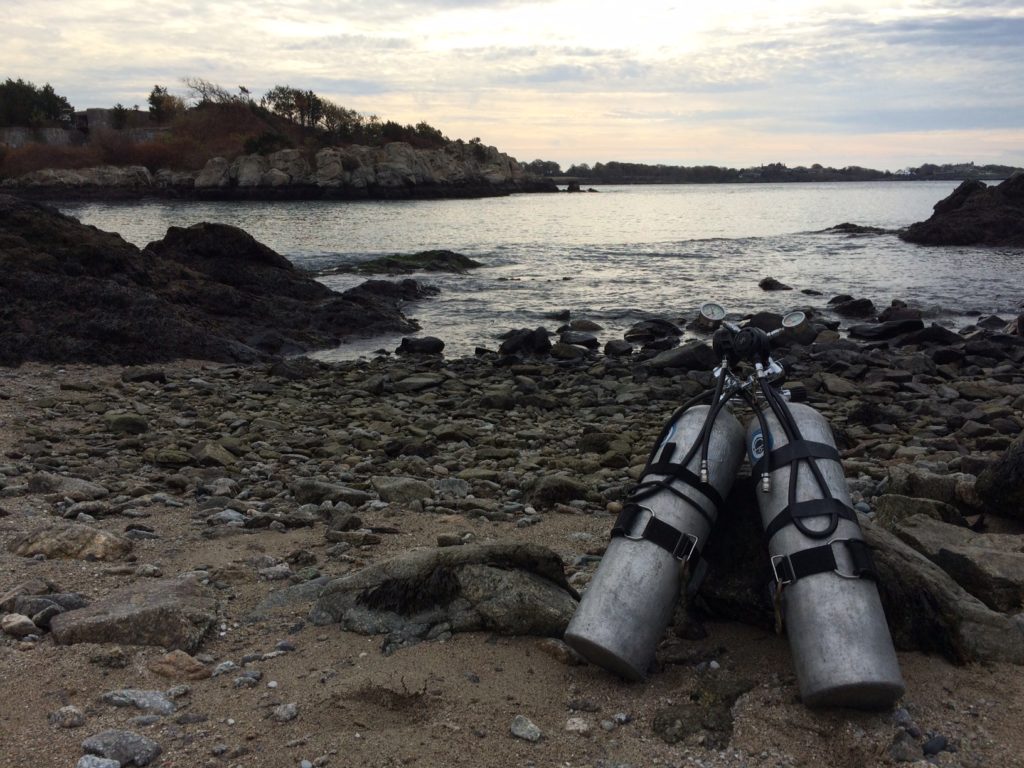 My technical beach excursions have gained some attention the last few weeks, and I suppose with reasons to be understood as I schlep a diver propulsion vehicle and a few sidemount bottles to the beach of our most popular local dive site where openwater training is the norm. Over the winter, I had the place to myself, but summertime brings scores of divers to Ft. Wetherill in Jamestown, Rhode Island, and my heap o’ stuff has raised some questions…
My technical beach excursions have gained some attention the last few weeks, and I suppose with reasons to be understood as I schlep a diver propulsion vehicle and a few sidemount bottles to the beach of our most popular local dive site where openwater training is the norm. Over the winter, I had the place to myself, but summertime brings scores of divers to Ft. Wetherill in Jamestown, Rhode Island, and my heap o’ stuff has raised some questions…
Well, I started ‘Sidemount Saturdays’ as a means to blow some steam (or bubbles anyway) and get away for a local dive. Between work dives and expedition travel over the last bunch of years it had dawned on me that I wasn’t as connected to the local scene as I should be, so I’ve made best efforts to get out there to keep my own skills sharp, and continue experimenting with some new techniques for extended range beach diving. At some point here soon, anticipate a lecture about ‘Diving Big in your Backyard’. As far as open-circuit scuba goes, I’ve been diving sidemount almost exclusively to save stress on my back. Once I dialed in that configuration for openwater diving, I introduced a 2000 LF survey reel [custom], and then after dialing that in, introduced a DPV tricked out with some custom lights by Juice Robotics.
My plan has been, and continues to be, making incremental improvements and advancements to the technique of extended range beach diving with the hopes of seeing some sights that have been well out of reach from shore, and not always accessible by boat. In time, I hope to incorporate my full suite of recently developed tools including Ocean Space Habitat and our new Unmanned Surface Tender to have a fully integrated suite of tools to vastly extend the range of dives from the beach. I can envision diving ‘the wall’ in the Exumas from the windward side of the cays…epic run!
Here in Rhode Island, low visibility can be a challenge – this lends itself well for training exercises, and is also cause for adopting navigation techniques for cave diving (carefully placement of lines, etc). In openwater tides and currents can be tricky, but I’ve worked through it by using rock climbing cams and wedges to create more secure tie-in points.

Anyway, this past Saturday was a special one for me – dive #4000. It went something like this…
At Wetherill, I schlepped my gear down to the left cove in three trips. The tide was just starting to ebb, so conditions were calm. Visibility in waist deep water looked pretty good, but after dropping down to 15 feet, I had nothing but a muted brown-green haze. Keeping the rocks on my right, I headed South/Southwest, basically following the shadows of the rocks as they contrasted with the sandy bottom. At this point, I’ve made this dive at least several tens of times, so was able to paint the picture of the excursion in my head as I went, even despite the poor visibility. As I left one shadow , I would use my DPV to scooter ahead 15-20 feet to the next silhouetted rock. This helped me stay on target without inadvertently swimming off-line and losing my natural navigation aids. As I approached the end of the big rock formations, an area of rubble breaks down from about 35 feet to 60 feet. As I made my way down this contour, visibility broke open a little bit, but as I got below the hazy layer, naturally light was diminished and it got very, very dark. Once hitting 60 feet, I paused for a minute to check my air supply, and decided to switch bottles just shy of hitting 1/3rd of my right hand cylinder. I did a quick s-drill for myself, verifying location of regulators, knives, and other safety equipment, then carried on. Towards the end of the slope, some large rock formations appear again. I continued to track these, keeping them on my right as I drift along out into deeper water which lines the channel. Fortunately, the tide hadn’t started to move quite yet, so it was relatively calm.
Approaching 80 feet, I flipped on my lights. I only waited this long, as I needed my eyes to adjust so I could follow the silhouettes of the rock faces this far. However, out here a the edge of the channel, the rock formations are a bit craggy, with various overhanging ledges, and I needed some light to more carefully meander through them. I arrived at a sandy patch in 85 feet and paused for a minute. A few cunner were attracted to my lights and seemed to be following me for a while. I did another s-drill, and at this point switched cylinders again. Now, my mistake has been watching Shark Week at night, so the fleeting thought of a shark being attracted to my lights made me shut them off. I sat still for a few minutes to let my eyes reacclimate to the dark, and then carried on. I followed this sandy patch downward to 92 feet but then couldn’t shake the thoughts of a shark – while this would be a highly unlikely encounter at this particular site, being alone, in the dark, and just within the margins of nitrogen narcosis which is amplified with any bit of stress, I decided it was time to start making my way.
Keeping the sandy slope on my right, I trekked ahead until my compass redirected me North/Northeast. At this point I realized I was around the corner and headed into the next cove. So, I began a preliminary ascent to get out of the channel and back up into the craggy rocks which started around 80 feet. I continued to proceed up to 60 feet where I settled in to a short sandy patch and then sat for a couple of minutes – another s-drill, another air supply verification, and then just enjoy the peace. I knew from dives past that once I left this spot and made my way around the corner to the next cove, wave action at the surface would often be felt as deep as 40-50 feet. This is one of the reasons why I carry a DPV on this dive…not so much for the distance, but to help buck the force of the water as I move from deep to shallow water.
So, I continued on my way again keeping the rocks on my right. Every so often I’d inadvertently leave the rocks, but between a relative compass heading and paying close attention to the sand slope (even a few degrees of slope has become enough for a natural navigation aid), I’d end up back on course. While I stayed clear of required decompression, my meander to the deep end of the excursion put me relatively close to my no decompression limit. As I approached 40 feet on the return, I could feel the tension in my tissues. Most people don’t believe my sensitivity to this, but it first became a realization when working the Woonsocket Falls Dam Rehabilitation Project. For weeks on end, I was pushing 6-7-8 hour days on the bottom in very shallow water, and could ‘feel’ the tissue tension when ascending up the ladder at the end of the day. According to DAN, there should be no issue with very shallow water decompression sickness, but I’d argue differently. At the time, when I was diving every day for work, my tissues were like elastic and exercised with the uptake and release of nitrogen. As I’ve sat around with more administrative duties, I feel like this elasticity has faded away to atrophy. Now, that same ‘feeling’ comes and goes on some of these deeper dives, which makes me very cautious to make long safety and decompression stops when needed. While that feeling gives me pause during a dive, it is also a reminder of just how far I’ve pushed myself over the last 20 years. Maybe it is time to be a bit more conservative…
As I pressed onward to the shallows I lost my bearing for a brief minute. I took the opportunity to rehearse some navigational techniques that would help if I were really lost, which i wasn’t as I’ve been in this spot multiple times before. I ended up arriving exactly where I wanted to be, at the edge of an eel grass bed in about 15 feet of water, where I just layed down in the sand to ride out a solid 5 minute safety stop. Thereafter, I scootered due east, passed several groups of dive students who were just beginning to ‘get their feet wet’, and surfaced at the old boat ramp. 65 minutes after leaving the other cove, it was time to pack it up for the day. Dive 4000 complete.
I’m frequently asked about solo diving and some fo the techniques I’m employing on these big beach dives. According to SDI, I am a ‘Solo Diving Instructor’, but card waving hardly means much in the real world. What’s most important is planning – planning for contingencies, planning for emergencies, planning for self-help scenarios, and most importantly – planning for success. I like the challenge, I like the solitude, and I like the peace that comes with being out there on the edge. In some, but not all cases, a diving companion is a distraction from the focus needed to execute dives like this, as your mind shifts from acute survival mode to babysitting mode (regardless of how qualified the companion is). It’s an interesting debate…
As for continued development – I’m still working through some of the tools and techniques to make these extended range beach dives all that they can be. For anyone interested in lending a hand – think Sidemount Saturdays, and get in touch!




